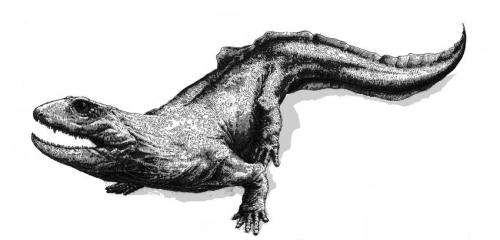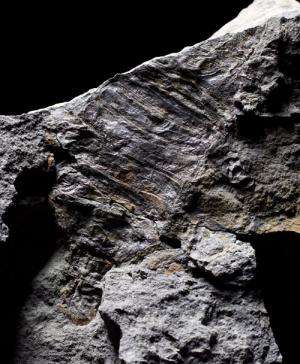March 6, 2012 report
Fossil finds help fill in Romer's Gap

(PhysOrg.com) -- A collection of new fossil finds in Scotland that date back to the 15 million year period between 345 and 360 million years ago are helping to fill the almost blank fossil record during a period that had until recently been considered to be essentially devoid of life except for that which lived in the seas. The discovery of the fossils by a team led by Jennifer Clack of the University Museum of Zoology at Cambridge and paleontologist Stanley P. Wood, is forcing archeologists the world over to do some rewriting of the history books. They have published a paper describing their discoveries in the Proceedings of the National Academy of Sciences.
Prior to these recent fossil finds, archeologists had taken to thinking of the time that came after a mass extinction some 359 million years ago, as very nearly empty regarding land biology due mainly to the almost complete lack of fossil evidence (only a single skeleton and a few bones had ever been found). Because of this, some theorists had suggested that there was likely too little oxygen in the air during this period to support such life. Now however, because of these new finds, those theories will be tossed to the wind.

The fossils were found in a part of Scotland known as the Borders, or Scottish Borders, which is a government council area east of Edinburgh and consists of hundreds of artifacts, both vegetative and animal. And because some of the fossils are of animals with developed toes, historians will have to push back their estimates of when such animals first evolved as well.
The finds are being attributed mainly to Wood who has reportedly been on a twenty year mission to uncover just such a treasure trove due to his belief that the hole in the record, known as Romer's Gap after Alfred Sherwood Romer, the American paleontologist who first pointed out the gap in the fossil record, was due to an inability to find artifacts, rather than an absence of land dwelling plants and animals during this important time in evolutionary history.
The BBC is set to air a program called “Evolution's Missing Chapter” about the team and the discoveries they’ve made and those who wish to see the fossils first hand will be able to do so shortly as they will be on display at the National Museum of Scotland in Edinburgh.
More information: Earliest Carboniferous tetrapod and arthropod faunas from Scotland populate Romer's Gap, PNAS, Published online before print March 5, 2012, doi: 10.1073/pnas.1117332109
Abstract
Devonian tetrapods (limbed vertebrates), known from an increasingly large number of localities, have been shown to be mainly aquatic with many primitive features. In contrast, the post-Devonian record is marked by an Early Mississippian temporal gap ranging from the earliest Carboniferous (Tournaisian and early Viséan) to the mid-Viséan. By the mid-Viséan, tetrapods had become effectively terrestrial as attested by the presence of stem amniotes, developed an essentially modern aspect, and given rise to the crown group. Up to now, only two localities have yielded tetrapod specimens from the Tournaisian stage: one in Scotland with a single articulated skeleton and one in Nova Scotia with isolated bones, many of uncertain identity. We announce a series of discoveries of Tournaisian-age localities in Scotland that have yielded a wealth of new tetrapod and arthropod fossils. These include both terrestrial and aquatic forms and new taxa. We conclude that the gap in the fossil record has been an artifact of collection failure.
Journal information: Proceedings of the National Academy of Sciences
© 2011 PhysOrg.com



















